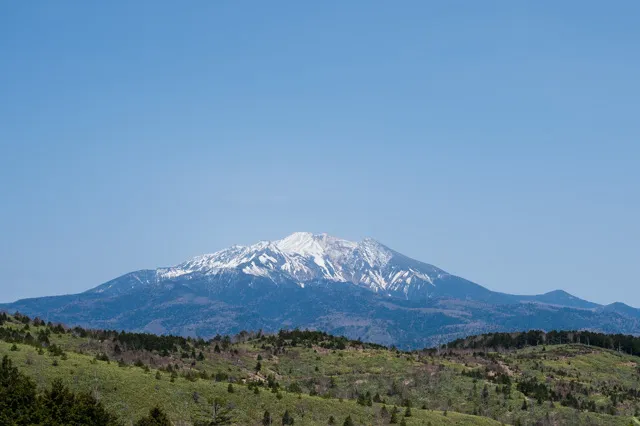By Elliot Hale
Copyright soranews24

With a historical pilgrimage route and a skyline road above the clouds, Mt. Ontake offers a journey through culture, spirituality, and breathtaking nature.
Japan is a country filled with history and beautiful natural scenery. One thing that it has no lack of is mountains, with Mt. Fuji taking pride of place amongst them as Japan’s tallest. It attracts thousands of hikers annually, but has started implementing stricter controls and higher fees for those wanting to ascend its peak. It’s certainly a beautiful mountain, but there are countless others that are also worth exploring.
Standing proud at 3,067 meters (10,062 feet), Mt. Ontake is Japan’s second-highest volcano, coming in only behind Mt. Fuji, and has long been regarded as one of Japan’s most spiritual mountains. Often listed alongside Japan’s Three Holy Mountains—Mt. Fuji, Mt. Haku, and Mt. Tate—it has been worshipped for over 1,300 years, and has long been used as a location for Shugendo, the practice of mountain asceticism, where practitioners venture into the mountains offering prayers and seeking enlightenment.
▼ Deities believed to dwell at Mt. Ontake
Located on the border of Nagano and Gifu prefectures, it was once seen as the location for an important pilgrimage for worship, but after a couple of ascetics opened up the routes to the common people in the late 1800s, it now also offers up its slopes to intrepid hikers who want to enjoy its stunning views.
The main climbing season runs from late June to early October, when the mountain and trails are clear of snow, and the lodgings on the mountain open up.
In terms of volcanic activity, Mt. Ontake has been livelier than Mt. Fuji, having caused the death of 63 people in its most recent eruption in 2014. As such, climbers are requested to check the most recent information on the official Mt. Ontake website before they start and come prepared with helmets as the bare minimum.
Of course, hikers should not forgo the other essentials: sturdy boots, additional warm clothing, snacks, plenty of water, and sunscreen. If you plan to stay overnight at one of the mountain lodges, consider bringing a sleeping bag, but some of the lodges do prepare futons and pillows for their guests.
There are several lodges on Mt. Ontake’s slopes, but reservations are generally required. Most of the lodges accept reservations only through a phone call, but Ni-no-Ike Hutte and Go-no-Ike Koya Mountain Oasis allow reservations to be made through the Line messaging app and their website, respectively (links at the end of this article). Throughout all of the lodges, prices can range from 6,500 yen (US$44) for a one-night stay with no meals to 17,000 yen for a stay with dinner and breakfast, depending on time of year and the lodge in question.
Getting to the mountain is pretty straightforward, taking the JR Chuo Line from Nagoya to Kiso-Fukushima Station, which will take about 1.5 hours.
From the station, you need to hop on a bus bound for Ontake Ropeway, one of the most common starting points, for around 50 minutes. The ropeway will take you up to 2,150 meters (7,053 feet), on a gorgeous 15-minute ascent, making the climb a lot more manageable. From there, you follow the more modernized hiking route along the Kurosawa Trail. While it’s not strictly necessary to use the ropeway, as the mountain can still be climbed from this direction with an extra 1-hour-and-40-minute climb via the abandoned hot spring Naka-no-Yu, it does make the journey a lot easier. However, it’s also possible to use Naka-no-Yu’s former parking area, climb for 50 minutes, and you’ll find it converges with the same Kurosawa Trail.
The second most popular route, called the Otaki Trail from Tanohara Parking Area, is also serviced by a bus from Kiso-Fukushima Station, but only on weekends and holidays. The Otaki Trail, alongside the Kurosawa Trail, forms the traditional Ontake Pilgrimage Trail, creating a system of paths that connect shrines, waterfalls, forests and memorial stone monuments. If you’re up for a journey of more epic proportions following the full Otaki trail, you can start from the nearby village of Otaki at the foot of the mountain and climb your way up, past beautiful waterfalls, all the way to the summit. The Kurosawa Trail joins onto the end of the Otaki Trail at the summit; they have the same destination, but very different experiences.
There are a couple of other routes up the mountain as part of the pilgrimage trail network, but are much less traversed and a little longer. For instance, there is a third route: the Osaka trail. It’s located on the Gifu side of Mt. Ontake and starts at the secluded Nigorigo hot spring area, however there’s currently no public transportation access. If you have access to a car and fancy ending your climb with a stay at one of the surrounding hot spring hotels, this is also a great option.
▼ View from the Tanohara parking area
I took the route from Tanohara when I climbed the mountain last month, despite the one using the ropeway being more popular, and there were several reasons for this. First and foremost is that I had to squeeze the climb in between other commitments, so it being the shorter of the trails was ideal. From the ropeway, it’s about 7.5 kilometers (about 4.6 miles) and takes between 5.5 and 6.5 hours, whereas it is roughly 5.7 kilometers (about 3.5 miles) from the Tanohara Parking Area, and takes between 4.5 and 5.5 hours (all times vary depending on walking speed, as well as number and length of breaks).
▼ The entrance to the hiking course from the parking area
Neither route requires you to be a professional mountain climber, after all I spotted a couple of young children taking on the climb without much issue, but if you find yourself panting at the top of a short flight of stairs, you should perhaps give it a miss. You should also be aware that exercise at this altitude can be a little more taxing than normal, due to the thinner air, so prepare for more breaks than you would usually take.
Taking the trail from Tanohara also allowed me to start higher up without needing to use the ropeway. While paying the 2,600 yen round trip fare was feasible, I needed to start earlier than its operating time of 7:00 a.m. on weekends and holidays, or 8:30 a.m. on weekdays.
Also note that if arriving by bus, it will require a one-way fee of 1,500 yen or 2,500 yen for a two-day pass. There are only four buses that run each day: from Kiso-Fukushima Station they depart at 8:40 a.m., 10:40 a.m., 1:50 p.m., and 2:45 p.m., but that last one only runs on weekends and holidays. The last bus back to the station departs at 4:45 p.m., so be sure to factor that into your planning. Additionally, from September to November 3, there will only be three buses running, doing away with the 2:45 p.m. bus, and with only a slight change in the last bus back being at 4:20 p.m. instead.
On the other hand, if you want to catch the bus to Tanohara, you can get on at Kiso-Fukushima Station, either at 8:40 a.m. or 1:45 p.m., remembering of course that they only operate on weekends and holidays and will run only until October 19 for this climbing season. This bus journey will set you back 2,500 yen for a round trip. The return journey leaves Tanohara at 10:45 a.m. and 3:50 p.m..
The other main reason for using this trail was that the road to the parking area would allow me to drive on the Ontake Skyline, a free public road that takes you to a height over 2,000 meters (6,561 feet), above the clouds, along a winding path and past breathtaking scenery. If you ever feel like driving on top of the clouds, then this road is not to be missed.
At the Tanohara Parking Area is a recently built visitor center, which also offers a helmet rental service if you don’t happen to have one of your own—you’ll need to have some form of ID and 2,000 yen in cash on hand for the rental. There are also plumbed toilets nearby, if you struggle to leave behind the comforts of modern living. More significantly, it is home to part of Ontake Shrine, where those unable to make the pilgrimage up the mountain can still worship. As an extra bonus, there’s the Tanohara Natural Park for people to walk around and enjoy the mountain’s atmosphere and views.
Following the path up the mountain, you pass worship sites at the 8th and 9th Stations, as well as some tiny shelters.
Unlike the trail from the ropeway, the route from Tanohara doesn’t have any large lodges, or even toilets, until you get to the summit evacuation shelter, about a two-hour climb from the parking area, where the toilet costs 100 yen for each use (bring coins). So, if you’re particularly worried about the availability of facilities, or want the reassuring presence of the people who work in the lodges in case something unfortunate were to happen, you will want to take the other route instead.
▼ The shelters at the 8th and 9th Stations barely have enough room to lie down in, let alone have a toilet.
You will pass alpine plants and flowers, and witness the gradual change to a more volcanic landscape the higher you get, contrasting greatly to the lush greenery at the start of the hike.
Looking back down the mountain offers impressive views out of the surrounding mountain ranges, if you’re fortunate enough to climb on a clear day.
▼ I, sadly, was not blessed that day.
Next to the summit evacuation shelter is the main part of the shrine at the top of the mountain, although there is a smaller shrine right at the peak.
▼ The manned evacuation shelter
Here you can even pick up a goshuin shrine seal stamp if you happen to be collecting, so be sure to bring along 500 yen in change, because the shrine is generally unmanned, and operates on an honor system.
Past the shelter is a short stretch where there is no cell network coverage, so don’t stop moving and keep an ear out for any warnings broadcast on the speakers.
This is where things can suddenly take a turn for the worse if Mother Nature is having a bad day. Along the trail are signs that tell you to keep moving, limit any water breaks, and try not to sit down. Once you get to the summit, you can relax a little more, but this short part of the trail is clearly an area to be wary of.
▼ Make haste through this region
At the summit, there are some small shelters, a little shrine, and, if the clouds are willing to play nice, fantastic views.
▼ The post indicating the summit of the mountain with the mountain name and height
If luck, and the weather, is truly on your side, you’ll even get to see Mt. Fuji greeting you from the horizon. If the weather isn’t that great, you can still look down over two of the summit’s five lakes. Ni-no-Ike, the second of the lakes, is the highest lake in Japan, but it became filled with volcanic ash during the eruption, and remains quite murky to this day.
▼ Ichi-no-Ike is on the left and Ni-no-Ike on the right
Coming down from the mountain, you shouldn’t feel the need to hurry back to the city. The train line follows part of the Nakasendo, one of the historical routes that connected Kyoto and Edo (now Tokyo). The post-towns in this region are like taking a step back in time, allowing you to feel what rural Japan would have been like over a hundred years ago.
There are no major rules to follow on the mountain, just stick to the trails, take your trash home, and greet your fellow hikers with a cheery “konnichiwa.” Remember that, like many mountains in Japan, Mt. Ontake is a place with deep cultural and spiritual roots, so treat it with the respect it deserves. By doing so, you help preserve both the landscape and its cultural legacy for future generations. It might not be Japan’s most famous mountain, but the experience is just as rewarding.
Related: Ontake website, Ontake Ropeway, Mt. Ontake Visitor Center, Ontake Ropeway Bus Information, Tanohara Bus Information, Volcanic Information, Ni-no-Ike Hutte, Go-no-Ike Koya Mountain Oasis
Photos ©SoraNews24
● Want to hear about SoraNews24’s latest articles as soon as they’re published? Follow us on Facebook and Twitter!



